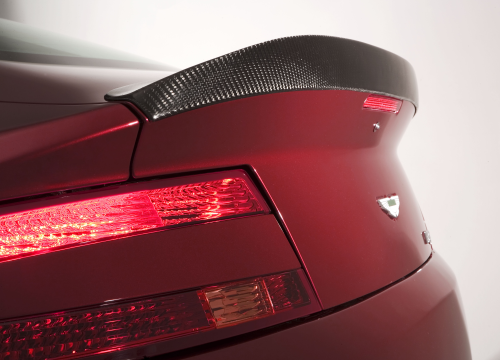
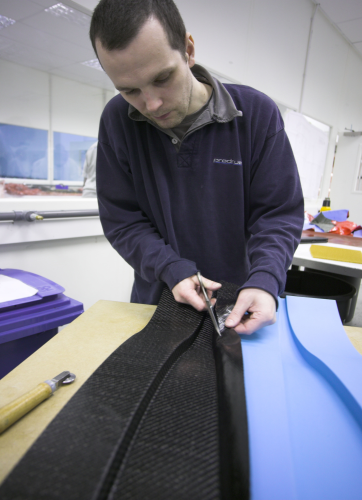
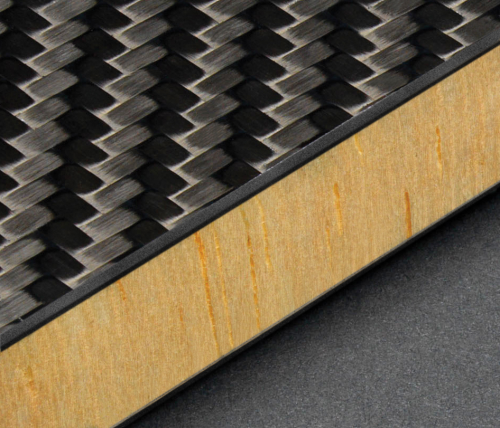
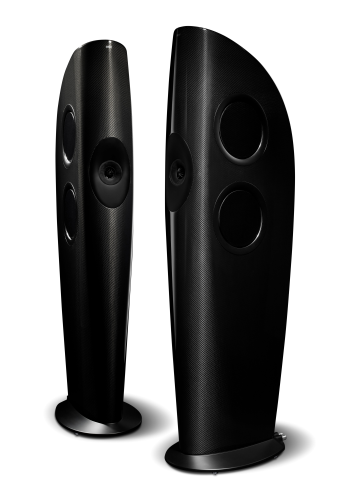
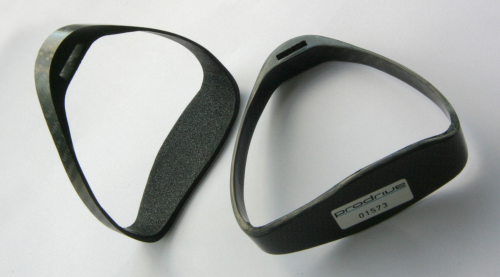
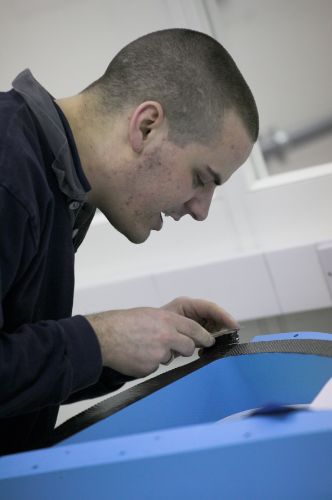
Until now, the demand for a smooth, high gloss finish on composite parts has necessitated spraying a lacquer coat over the finished surface. Unfortunately, any surface chips (e.g. from minor impacts and abrasions) can cause the lacquer to delaminate from the carbon substrate, leading to unsightly white blotches, while prolonged exposure to ultraviolet (UV) light can cause a yellow discolouration.
“It’s highly unsatisfactory if a large panel, like the aerodynamic diffuser on a sports car, has to be replaced after a few thousand miles due to cosmetic deterioration when the part is, functionally, still perfect,” comments Gary White, Prodrive’s composites engineering manager. “We now have a finish which is so good that we can dispense with the lacquer entirely so we have multiple benefits: piece part cost reduction, better durability in service and improved consistency of appearance.”
The long term quality of finish on composite parts is of great importance in an increasing range of applications including automotive, marine and furniture – wherever there is a need for strength with light weight or a ‘high tech’ premium appearance – but achieving this has not been easy.
“In 20 years of working with composite parts, I’ve never seen such a consistent, high gloss surface finish produced without lacquer,” advises White. “We even produce surfaces with AA finish quality by the lacquer-free process.” (AA finish quality is specified for the most important visual items, such as automotive interior trim.)
To achieve the exceptional finish, Prodrive analysed the fundamental process steps required to produce a carbon composite part and identified the parameters that affect surface finish. One of the key areas is very precise control of the interface between the component and the mould. As each of the composite layers (the plies) is added to the mould, there is a possibility of air bubble entrapment which hinders both adhesion between plies and seating of the outermost layer against the mould surface. The Prodrive process achieves outstanding results by the use of carefully developed values of pressure, temperature and duration for this phase of the manufacturing process.
“We have established a set of process conditions that give the best possible consolidation of the outer layer against the mould surface,” says White. “We also pay particular attention to the mould surface finish and have developed an appropriate prepreg specification with our supplier.”
Modern craftsmen
The process begins with cold storage of bulk material at -18°C to prevent deterioration of the resin; it has a shelf life of 12 months when frozen but would be unusable after 30 days if left at room temperature. Rather than use standard materials, Prodrive has its own specifications for different applications.
After 24 hours at room temperature to stabilise, prepreg sheet is dispensed from a roll and the parts required are marked out on a large flat-bed plotter using a CAD programme to arrange them for minimum wastage; utilisation is typically 90%.
As part of Prodrive’s quality assurance, each part is identified by a unique label from this point, enabling tracking throughout manufacture and during service; the labels are tamper-proof and are destroyed by attempted removal.
Four teams, working in parallel, hand lay the prepreg parts into moulds; depending upon the number of parts required the moulds are made of carbon composite or aluminium alloy. A composite mould is capable of making approximately 250 parts whereas aluminium tooling lasts indefinitely.
Successful application of the laquer-free process requires high levels of skill and concentration from the operators who must physically manipulate the prepreg into every corner of the mould without breaking the fibres. Prodrive trains its own technicians to the highest standards to carry out this role, the training taking between two and three years. Fully trained composite technicians are modern craftsmen, working with resin and fibre instead of metal, wood or leather.
Once in the mould, the part is surrounded by a vacuum bag that is evacuated prior to loading the assembly into an autoclave, along with similar parts to make an economic batch. The vacuum action helps to eliminate air pockets in the resin that might otherwise lead to voids or delaminations. The autoclave heats the component under pressure, typically for around an hour.
After baking, the part is removed from the mould and trimmed by hand or CNC machine, depending upon the accuracy required, the difficulty of the operation and the complexity of the tooling. Air tools are used because carbon dust is attracted to electrical machines. Hand polishing takes place before final inspection.
Quality standards
The first production application of the Prodrive process is the supply of various panels and assemblies for a new European supercar. Prodrive’s contribution extends beyond the supply of components to include writing new production quality standards for the client, appropriate to the new process. When the company’s engineers approached Prodrive, they assumed that a lacquered finish would be essential.
White takes up the story: “All their quality processes were based on a lacquered finish. The issues you control with an unlacquered surface are completely different. For instance, spray finishes can suffer from runs and fish eyes; non-sprayed finishes can suffer from pin holes. We wrote new quality standards for them to reflect this, and they were delighted; they not only received top quality parts from us but developed their supplier quality standards for the future.”
Other customers are now requesting parts made by the Prodrive process. Where prior tooling exists, a level of refurbishment must be expected to bring the surface up to the necessary standard. Significant production quantities can be handled – currently Prodrive’s biggest application is approximately 400 parts per month. Cell-based manufacture with predominantly manual operation means the process can be scaled as required to suit the volume demanded.
Prodrive provides a full service to clients unaccustomed to the application of composite materials, in order to provide reassurance throughout the design stage and assured quality during manufacture, supply and into service. The simplest step is materials substitution, where composites replace existing materials without a substantial redesign of the product. This can bring significant benefits in weight, durability and maintenance, but even bigger gains come when the client’s engineers are confident with the material and can fully exploit its properties at the design stage.
Prodrive’s culture is to develop imaginative, practical and cost-effective solutions to meet technical challenges. The Prodrive process is one manifestation of this but, behind the scenes, there are many others.
“Another well known sports car manufacturer came to us for the supply of highly visible composite parts," White continues. "They had successfully accommodated the structural and dimensional requirements but were unhappy with the cosmetics. We were able to satisfy all three requirements by controlling the weave direction in every part. We are especially pleased about that job. Our quality and on time deliveries have impressed the customer so much that we are receiving ongoing requests for quotations despite recessionary pressures at the customer to bring such work in house.”
Other applications
Away from automotive applications, Prodrive’s customer base for composites includes aerospace, telecoms and marine applications but one of the most unusual must be top end HiFi.
Loudspeaker manufacturer KEF formed a technical partnership with Prodrive to produce a concept design called the Blade which relies for its stunning visual appeal upon a carbon composite enclosure with a very high quality exterior surface finish. The structural properties required, such as stiffness and natural frequency, were carefully managed by Prodrive and KEF engineers to give an acoustically ‘dead’ loudspeaker enclosure.
“People not working in this field tend to associate carbon composites only with high strength panels and structural parts for racing cars,” says Prodrive’s composites sales manager, Matthew Bradney. “This is actually only a small part of the material’s capability; the density, the choice of fibre and the weave direction can all be varied; the ‘meat’ in the composite sandwich can be aluminium honeycomb, balsa wood or none at all in the case of a solid composite part. No conventional engineering material can offer such versatility.”
Being chemically inert, composites offer a major saving in maintenance requirements compared to metallic materials when used in maritime applications, as corrosion protection is not required. Prodrive supplies composite products for such diverse marine uses as offshore platforms and racing yachts. The platform application used the superior abrasion resistance and lighter weight of the composite material to improve life and reduce maintenance costs for crude-oil filters, previously made from steel; the yacht application was a highly loaded winch housing for an Americas Cup competitor, where both weight and durability were improved over metallic materials.
Large-scale structural uses of composite material have included the flybridge on luxury yachts and both the hull and superstructure of offshore rescue boats. Large, thick-walled sections are produced using a proven technique that involves resin-infusion under vacuum; no autoclave is required so there is virtually no size limitation with the process.
At the opposite end of the size range, Prodrive has supplied carbon composite stirrups to top jockeys, for whom every gram is important. Saving 100 g compared to aluminium stirrups, a composite pair weighs approximately 40 g – about the same as a large packet of crisps. The application required detailed finite element analysis of the fibre lay-up to ensure no possibility of failure because carbon splinters are not revealed by X-ray so any injury to the horse could be difficult to detect.
Gary White concludes: “You’d be amazed how many people think carbon fibre is just carbon fibre. Our approach to each new application is to take a holistic view and capture all the requirements. The end product doesn’t cost any more but often has more functionality and helps our customers to be more competitive.”






